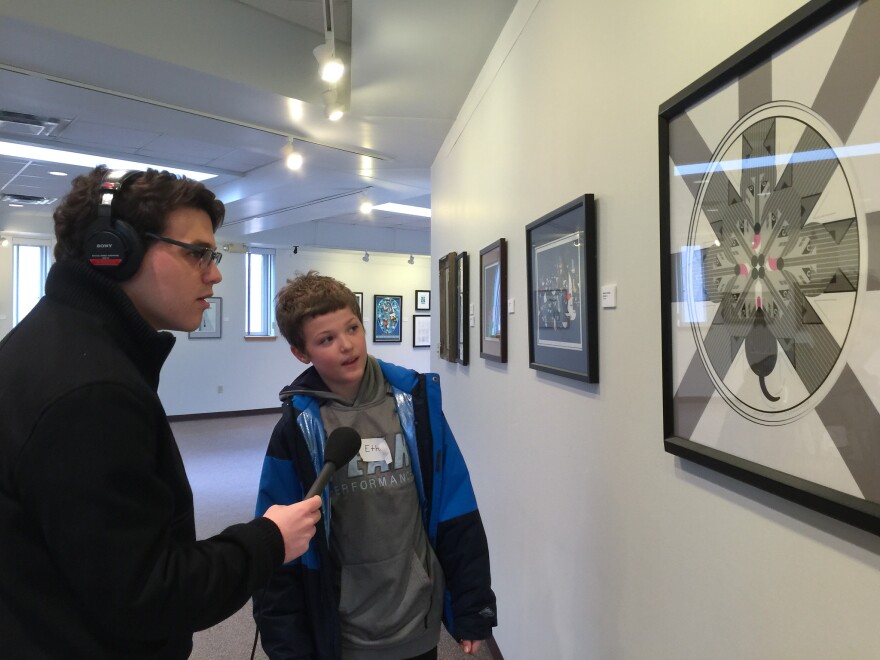Charley Harper is famous in the art world for his simplistic views of nature. Birds, trees, and plants are depicted with lines, bold colors and carefully arranged, geometric shapes. That simplicity attracted the Kalamazoo Nature Center. It’s brought in an exhibit of Harper’s work to use as a teaching tool.
On a Tuesday afternoon, a rumbling group of fifth-graders pack the center’s animal-filled halls. The kids from 12th Street Elementary School have just spent an hour learning all about the artist Charley Harper and his geometric prints of nature. Now, they’ve got their own nature pictures.
“I drew one of the owls, two of the birds, all the shapes that he used," says one. "He used over like twenty, or something. I drew a polar bear."
From another: “My favorite was the painting over here. There are a lot of wolves and a lot of dogs and all he did was use rectangles, triangles, and a couple lines that just go in different directions and make it look like there are a ton of wolves. But they're made of different lines."
Harper’s exhibit is relatively new to the Nature Center. It only premiered here in early February as a partnership with Kalamazoo’s Education for the Arts program. Harper is notorious in the art world for his unique style, called “minimal realism” with bold shapes and lines. A wing becomes a yellow triangle. A dandelion becomes a set of stark, curved lines.
The organizations saw the simple-yet-complicated art as a perfect opportunity for learning. Full of meaning, but accessible enough for kids to understand.
"And even the children today said, 'Well, it's just simple shapes!' But it's really complicated, the way he pulls it all together using nature," says Mary Whalen, a teaching artist with Education for the Arts. "But he breaks it down to these simple shapes."
Whalen says that literally being in nature helps to make these ideas really stick. A painting of a chipmunk is fine. But when you can look through a window and see that chipmunk in the wild, then compare it to the picture? That’s something a kid’s going to remember.

"And the other things that happens, you know, we look out this window and see birds and squirrels. And actually we've seen all different kinds of birds here," she says.
Looking outside a large window near the Harper gallery, Whalen continues.
"It's kind of quiet now but we're lucky to see this cardinal. But in the children, this is a magnet. This window is a magnet for them."
Outside those windows, along the nature center’s trails, you can take in the second part of the Charley Harper experience. It’s something you might miss if you’re not paying close enough attention. Ryan Koziatek, the center’s field director, winds through the shrubs and trees. About a hundred feet in, we stumble across something that obviously doesn’t belong here: A picture frame, supported by a wires, floating about five feet off the ground.
"The purpose of the frame is to kind of bring that focal point down. For a moment, lose that overwhelming complexity at times," Koziatek explains. "And then get a focus of what we're seeing. We crouch and peer through the frame at the branches and leaves above, cut off from the rest of nature."
These frames are scattered throughout the center’s Habitat Haven Trail. Some small, some large, framing all kinds of scenes. Koziatek says these take nature and simplify it down into smaller pieces. Just like Charley Harper did.
"As we look through that, we've focused our vision on this kind of square frame area," Koziatek says. "But even within that, there's some kind of complexity. So tying it back to Charley Harper, he would use those geometric shapes to still give the feel of the canopy, but bringing it down into terms that are aesthetically pleasing. Very beautiful."
Charley Harper brought nature onto the canvas. Now the nature center is bringing the canvas into nature. You can see the exhibit through the end of May at the Kalamazoo Nature Center.





